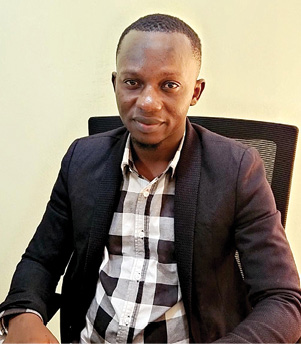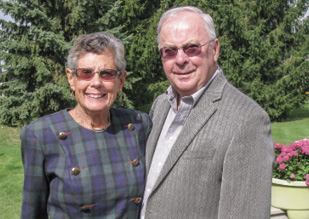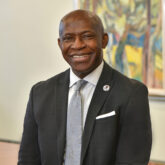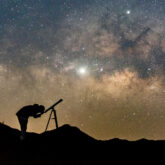 Frederick Bieber’s career revolves around science. But, his life has a lot more to do with serendipity.
Frederick Bieber’s career revolves around science. But, his life has a lot more to do with serendipity.
Chance meetings. Chance phone calls. The things you can’t measure in a lab or inspect under a microscope.
A recognized leader in the field of forensic pathology, Bieber has a list of credits that includes working with families in the aftermath of 9/11 and Hurricane Katrina.
“What’s amazing to me is that you never know what chance you have of running into someone and the impact that can have on the rest of your life,” says Bieber ’72, associate professor of pathology at Harvard Medical School.
That moment came in the middle of a classic Oswego snowstorm in 1968. While finding his way through the academic quad, Bieber quite literally bumped into English Professor Anthony Annunziata.
“We got chatting on the way to Hewitt Union, and he asked what I was reading,” recalls Bieber, who replied he was reading books for class and not
much else. “He said, ‘You should
be reading something outside of your school work. Here, take this. I just finished it and it was excellent.’”
The volume Annunziata Bieber — The Double Helix by DNA discoverer and Nobel Prize winner James Watson — changed Bieber’s academic trajectory immediately.
Bieber devoured the volume and enrolled the following semester in a genetics course taught by Harold O. Powers.
He considers his junior year internship with Jackson Laboratory in Bar Harbor, Maine, an essential career development experience. Bieber went on to grad school at the University of Rochester School of Medicine and earned his Ph.D. in human genetics at the Medical College of Virginia.
He joined the Harvard Medical School faculty in 1983. Bieber has worked in diagnostics of genetic disorders at Brigham and Women’s Hospital in Boston since the mid-1980s.
In 1989, he received a phone call from a district attorney investigating a case of recent sexual assaults. It was his first foray into forensics, something he’s been involved with ever since.
“This is the magic for me of genetics — it plays a huge role in human health,” Bieber says. “It also has impact on everything from immigration disputes to people who were convicted before the advent of DNA testing.
“You have a chance with genetics to unlock the secrets that eluded us in the past,” he says.
His kinship method of DNA analysis helped nab a serial killer dubbed the “Grim Sleeper” who had eluded Los Angeles authorities for more than 20 years. When an exact match could not be made with DNA found at the murder scenes, investigators put Bieber’s process of finding close matches to work and eventually linked the crimes to a man whose son was a suspect.
Once authorities had a hunch, they were able to collect DNA from a discarded pizza crust and make the match to the serial killer.
“The intersection of science, law and public policy are what interests me the most,” says Bieber, who became integral in identifying victims of two historic U.S. disasters.
He received awards for outstanding service for his work surrounding 9/11 from the U.S. Department of Justice and for his investigations after Katrina from the Louisiana governor. In both instances, Bieber was a part of a panel that linked family DNA to unidentifiable remains.
It was grim, but important work that inspired Bieber to join the U.S. Army Reserve, where he also worked to ID soldiers.
“It’s such a privilege to have this education,” says Bieber. “I really feel strongly that I have to spend much of my life giving that back.”
Born in Regina, Saskatchewan, Bieber joined his parents in emigrating to Rochester, where his father worked for Kodak.
“I wanted a college with a good science program that was conveniently located,” Bieber says. “I was looking for professors who were focused on teaching, but I also wanted professors who were able to guide me in terms of career post-college.”
The interaction of students and their professors at Oswego had a profound impact. He recalls visiting professors in their homes and working with them on projects. Sherret Chase, professor emeritus, took his class to Harvard in Bieber’s senior year.
“I tell my students that they’ll have lots of experiences in college. You never know which one will change your life,” Bieber says.
— Shane Liebler
Read more stories of Alumni in the Sciences
You might also like
More from Alumni Profiles
Astrophysicist, Yale Professor Credits Oswego with Setting His Course for Stellar Career
Astrophysicist, Yale Professor Credits Oswego with Setting His Course for Stellar Career Earl Bellinger ’12 is one stellar guy. A quick review …
BHI Alumnus from Liberia Gains World of Experience
BHI Alumnus from Liberia Gains World of Experience Otis Gbala M’23 became the first SUNY Oswego graduate who studied from Liberia …
Couple’s Loyal Support for Oswego Spans Five Decades
Couple’s Loyal Support for Oswego Spans Five Decades Marilynn “Lynn” Nagy Farrar ’61 and Neil Farrar cherish their memories of Oswego …











